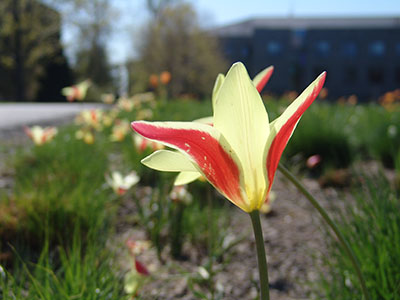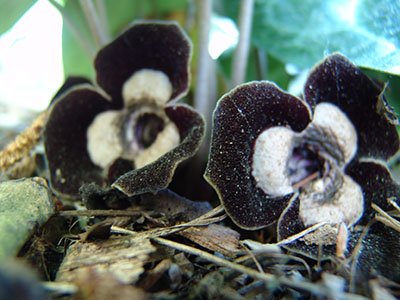
Magnolia ‘Elizabeth’
Though we are at the tail-end of peak time for magnolias, Magnolia ‘Elizabeth’ is still looking fabulous, covered in large, pale-yellow flowers and smelling faintly musty-lemon-like. Reportedly a cross between the North American species Magnolia acuminata and the southeastern Chinese yulan Magnolia denudata, M. ‘Elizabeth’ is a medium-sized tree generally maxing out at 35’-40’. Each year in late April it produces an abundance of flowers that persist until early May. According to AW Smith’ Gardener’s Dictionary, the genus Magnolia is named for 17th century French Royal Botanist, Pierre Magnol. A specimen of M. ‘Elizabeth’ can be found still in bloom just off of a corner of the Worth Health Center. photo credit: R. Maurer

Tulipa ‘Tinka’
Every spring, after the Sporobolus in the water retention beds are burnt to clumps with torches, they are not much to look at. That is until the grasses begin to pop up and the myriad of small bulbs emerge and color the space. This year the Tulipa ‘Tinka’ looked especially nice dappled among the tiny tufts of newly emerging dropseeds. Each petal is a lucid shade of light yellow, the outer three with a blush of red-orange. My sources don’t make clear the direct parentage of this tulip, but T. ‘Tinka’ appears to share characteristics with the Middle Eastern Lady Tulip, Tulipa clusiana, in coloration and general habit. Relatively small in size, Tulipa ‘Tinka’ works great in masses and as accents for pops of bright color early in the season. T. ‘Tinka’ can be found alongside other interesting cultivars and hybrid tulips in the retention beds on the north side of campus near the Science Center. photo credit: J. Bickel

Asarum maximum ‘Shell Shocked’
Talk about a funky flower. I have never seen anything quite like the flowers on Asarum maximum ‘Shell Shocked’. The common name “panda face wild ginger” says it all describing the bizarre black and white textured inflorescence. Three-sided and edged with velvety black petals that shift to a textured white, the cup-like flower is thick and and durable with dots of burgundy in the center. These flowers grow beneath the foliage on the ground, probably to promote crawling insect pollination and seed dispersal. The leaves are large and thick, tortoise-shell patterned, lustrous deep green, and often hide the flowers. The cultivar A.‘Shell Shocked’ was selected for the light-colored veins in the leaves that accentuate the pattern. You can find this deep in the Harry Wood Garden close to the dead-end. photo credit: R. Robert
